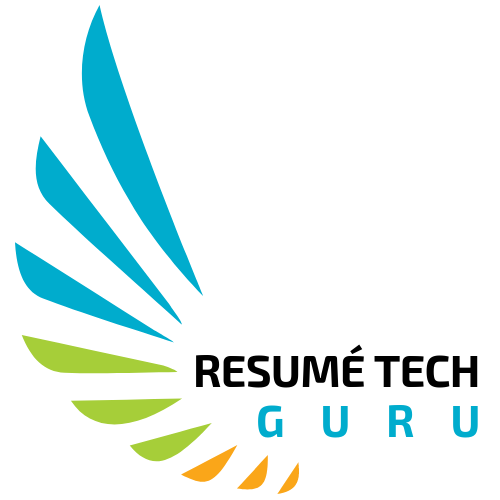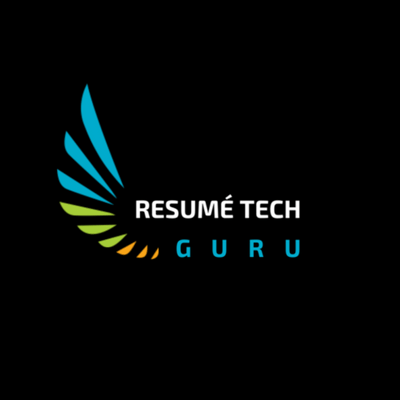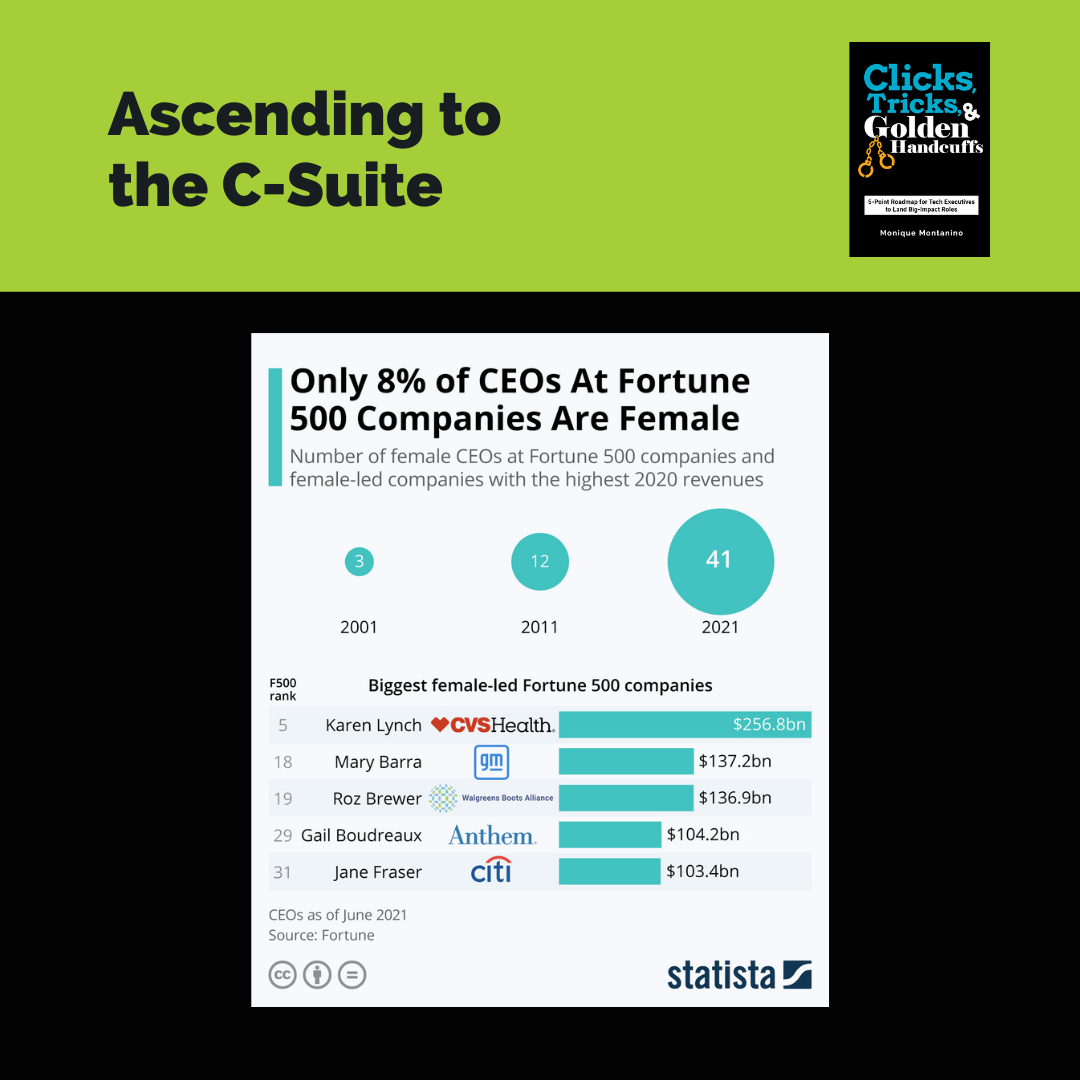Only 10. That’s the number of women I’ve collaborated with in the C-Suite or aspiring to join the club. And by C-Suite, I mean this alphabet soup—CEO, CTO, CIO, CFO, CISO, CDO, CSO, CMO, or CPO. And before you think my consulting practice doesn’t attract a CXO, my male client base measures in the hundreds who are at the top of their company’s org chart or plan to be.
So, what gives?
In my experience, it boils down to four things: not all women care to be in the C-Suite (shocker), hiring and promotion bias, lack of executive sponsors, and missing the skill of P&L ownership.
It’s a Numbers Game
Today the odds aren’t great for women in executive leadership.
- In 2021 only 41 out of Fortune 500 CEOs were women, that’s 8%
- Women held just 12% of named executive officer positions in Russell 3000 companies
- Women of color account for only 4% of C-Suite leaders
- Asian women account for only 1 in 50 women in the C-Suite
- Women are 1/3 as likely as men to be encouraged for a P&L role
If you want to be in the C-Suite or on a for-profit corporate board, P&L experience is imperative. I’ve owned 3 companies and was responsible for P&L for up to $1 million. There were highs (equity bonuses) and lows (layoffs). As a mentor, I strongly encourage women to find a finance rotation or work directly with a General Manager with P&L responsibility. Revenue, after all, drives corporate success on Wall Street. And sure, you need a fantastic product, terrific customer service, and employee satisfaction, but the bottom line is the focus.
If you are a woman interested in ascending to an executive leadership position, here’s what’s working for my clients.
Define your career vision
As I wrote in my book Clicks, Tricks, & Golden Handcuffs:
“Your career vision is related to developing your personal brand by creating a mental image of the future. It describes the absolute peak of where you envision yourself in your career. To plan, it stands to reason you need a destination. Consider your vision to be the North Star for mapping out your career success strategy.”
Defining your career vision is relatively simple. I developed a questionnaire to pinpoint a client’s long-term goals. Below are the questions and the examples I share to figure out someone’s career GPS.
Questions
- What are my values, including non-negotiables?
- If you could swap places with a person, who would that be and why?
- What’s the legacy I want to leave behind?
- Why is it essential to achieve success?
Examples
- Ascend to the CXO level at 45 and retire at 55.
- Be recognized as a well-known and respected leader in the AI domain.
- Become a leader in my organization, helping transform it into an organization that respects all its stakeholders.
For your inspiration, I’m sharing the stories of 3 women in different stages of their careers focused on the C-Suite. All client names that follow are changed to protect their confidentiality.
Only a decade into her work journey, Vanessa focuses on becoming a CISO by the time she’s 45 years old. Her career vision is to become an accomplished information security, privacy, and IT management leader with a strong business, risk, and technical background while at the same time being the best wife and mother. When we first met, she worked in an individual contributor security role for a billion-dollar digital workflow company.
Avril is a top executive at a Fortune 50 company. Last year she reached out to me about pursuing her next role as a CEO of a successful company that combines technology, business, and environmental impact to leave the planet in a better place.
Suzanne has an impressive background as a former CEO and executive at a FAANG company at the pinnacle of her career. In decompression mode from being in the C-Suite, her career vision pivoted to finding a position reporting to a CEO of a small company. It was time to relieve some of the stress of being at the organization’s top level.
These women had their career vision established; it was time to collaborate on their personal brand positioning.
Position your brand for career opportunities
What does your team or boss say about you when you are not in the room? That, my friend, describes your personal brand. It doubles as the key to your superpower for career moves within the tech industry.
People reach out to me to figure out their brand positioning for their next role.
Take Mary Beth, who was a senior director at the top cloud provider. She was 2 years from attaining her golden handcuffs (retirement equity compensation) and wanted a plan to pivot to a consulting role or become a CEO of a non-profit. Her ideal career move (pre-Covid) contributed to a larger vision, leading change and solving complex problems while working from home. Giving back, sharing knowledge, and empowering others were her priorities.
Here’s how she responded to my question regarding her brand:
“I love driving change (process), building a growth mindset, and empowering others with technology. I drive impact and delivery while grounded in clarity and vision strategy as an inspiring leader. My superpower is the ability to simplify complex areas while motivating teams to expand knowledge and deliver on results.”
When I asked her why someone should hire her—that part of your personal brand that makes you stand out—she said:
“My 20 years’ experience in core engineering, IT, and software development along with the multi-dimensional strengths with compassion towards empowering people, and technical expertise to bring the best solution, is top-notch!”
Another part of your personal brand is your soft skills and hard skills. Here’s how Mary Beth listed those:
Hard Skills
- Strategic Roadmaps/IT Strategy
- Program Management
- Product Lifecycle
- Artificial Intelligence & grant development
Soft Skills
- Collaboration
- Cross-functional team leadership & partner relationships
- Outsourcing & vendor management
- Thought leadership – strategy, vision, leaders who can connect the dots, up, out, and down
- Client-focused
- Problem-solving – analytics, statistics
Based on all this input, I optimized Mary Beth’s resume and LinkedIn and created an executive bio for her next career adventure.
It’s all in the execution
My clients are challenged to prioritize themselves either by workload or by family matters. It’s understandable.
Those in my practice pursuing the C-Suite have made inroads with a laser focus on their goal. It entails laying out a plan for the calendar year and executing consistently. Every single week without fail.
Vanessa negotiated an offer at a startup identity management company with 1,000 employees, 14,000 less than her former employer. She’s now a staff product security engineer. Her stepping stones for rising to CISO include an internal sponsorship by her company’s female CISO, speaking monthly at cyber security events, meeting with an outside-the-company tech executive mentor, and she’s volunteering at several STEM organizations.
Avril has executive recruiters reaching out with offers fitting her quest to become a CEO, but the domains didn’t always align. She joined the board of a women’s professional organization and is evaluating several for-profit board position offers with 6-figure compensation from annual cash retainers and RSUs (restricted stock grants).
Descending from the C-Suite, Suzanne took a job a couple of months ago at a cryptocurrency-related startup. She’s reporting to the CEO as SVP of Business Development. As a Chairman of the Board at a high-tech non-profit, she continues to be an adjunct professor at a renowned global research university.
While working with Mary Beth, a top 5 cloud provider contacted her for a CXO role. We discussed the pros and cons of this job. Fast forward 1 year later, she retired from her company and moved to the hometown where she grew up to take care of her elderly parents.
There’s no one path to or from the C-Suite for women.
I’ve noticed these women have a mentor, volunteer outside their company, and are active industry speakers. Even if you don’t aspire for the C-Suite but are looking for a new leadership position, perhaps it’s time to focus outside your corporate bubble?
Best to you in your career pursuits.



